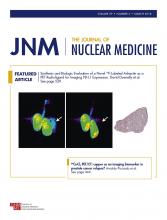PET imaging of SV2A: Rabiner provides an overview of recent developments in PET ligands for the synaptic vesicle glycoprotein 2A and the potential for investigating and monitoring brain pathology involving synaptic dysfunction.
Page 380
Chelate-free radiochemistry: Lamb and Holland review the evolution of nanoparticle radiochemistry and present 9 mechanistically distinct advanced methods for radiolabeling multimodality nanomedicines for SPECT/MR and PET/MR imaging.
Page 382
Dual-targeted molecular imaging: Ehlerding and colleagues outline the ways in which peptide-, antibody-, and nanoparticle-based platforms have affected the development of synergistic molecular targeting with 2 ligands.
Page 390
UEMS/EBNM and education: Frangos and colleagues from the European Union of Medical Specialists and the European Board of Nuclear Medicine offer commentary on activities supporting educational and certification standards for nuclear medicine specialists.
Page 396
Within-suite 89Zr PET/CT-guided biopsy: Cornelis and colleagues evaluate the feasibility of within-suite 89Zr-labeled PET/CT-guided biopsy performed without reinjection in metastatic prostate or breast cancer.
Page 399
68Ga-DOTA-RGD and nintedanib in NSCLC: Arrieta and colleagues investigate the potential of PET/CT imaging with this αvβ3 integrin−targeting tracer for monitoring treatment response with nintedanib, an oral angiokinase inhibitor, in patients with non–small cell lung cancer.
Page 403
Imaging immunotherapy workshop report: Shields and colleagues summarize the results of a May 2016 workshop at the National Cancer Institute on immune-modulation therapies and the most promising foci for imaging in clinical trials.
Page 410
Battle for PET reimbursement: Hicks provides commentary on the long-running and global efforts to achieve more broadly based reimbursement for PET applications and provides context for 3 articles in this month’s issue of JNM.
Page 418
Patient management after NaF PET: Hillner and colleagues use data from the National Oncologic PET Registry to assess the concordance of intended patient management after NaF PET imaging and inferred management based on analysis of Medicare claims.
Page 421
NaF PET and hospice care/survival: Gareen and colleagues use Medicare administrative data linked to the National Oncologic PET Registry to examine associations between NaF PET results and hospice claims within 180-d and 1-y survival periods.
Page 427
68Ga-PSMA-11 PET/CT and management: Calais and colleagues detail the results of a survey of referring physicians on whether and how 68Ga-labeled prostate-specific membrane antigen 11 PET/CT imaging affects the implemented management of prostate cancer patients with biochemical recurrence.
Page 434
Alternative copper-based PET in prostate cancer: Ceci and colleagues provide perspective on the proposed use of 64CuCl2 PET imaging in patients with biochemical recurrence and preview an article on this topic in this issue of JNM.
Page 442
64CuCl2 PET/CT in prostate cancer: Piccardo and colleagues report on the biodistribution, kinetics, and radiation dosimetry of this tracer in humans and on the ability of 64CuCl2 PET/CT to detect prostate cancer recurrence in patients with biochemical relapse.
Page 444
Hematologic dysfunction after PRRT: Bergsma and colleagues analyze persistent hematologic dysfunction after peptide-receptor radionuclide therapy with 177Lu-DOTATATE in patients with gastroenteropancreatic neuroendocrine tumors.
Page 452
177Lu-PSMA-617 dose escalation: Rathke and colleagues detail clinical observations on 4 different treatment activities of 177Lu-labeled prostate-specific membrane antigen–617 in patients with advanced prostate cancer.
Page 459
Proposed prostate PSMA PET criteria: Cho offers perspective and background on 2 new proposed prostate-specific membrane antigen PET criteria detailed in this issue of JNM and designed to facilitate prostate cancer reporting and classification.
Page 466
miTNM for PSMA-ligand PET/CT: Eiber and colleagues describe development of a molecular imaging TNM system as a standardized reporting framework for prostate-specific membrane antigen–ligand PET/CT or PET/MR imaging.
Page 469
PSMA-RADS 1.0: Rowe and colleagues propose a structured reporting and data system for findings on prostate-specific membrane antigen–targeted PET studies, with anticipated results in improving the consistency of clinical data generated in these studies.
Page 479
PSMA imaging in nonprostate cancers: Nimmagadda and colleagues describe prostate-specific membrane antigen expression in nonprostatic epithelial cells from publicly available genomic databases and characterize the potential of PSMA-binding agents to noninvasively detect that expression.
Page 486
Anti-PSMA ADC for prostate cancer: Lütje and colleagues explore the preclinical therapeutic efficacy of site-specifically conjugated duocarmycin- and monomethyl auristatin E–based anti–prostate-specific membrane antigen antibody–drug conjugates with differing drug-to-antibody ratios
Page 494
Curie score in high-risk neuroblastoma: Yanik and colleagues report on independent validation of the postinduction 123I-MIBG Curie scoring method in predicting treatment outcomes in children with high-risk neuroblastoma.
Page 502
β-amyloid and neuroinflammation in AD: López-Picón and colleagues evaluate longitudinal changes and correlations in β-amyloid deposition and neuroinflammation using 11C-PIB and 18F-GE-180 PET in a mouse model of Alzheimer disease.
Page 509
IRT vs. PET/CT in BAT: Law and colleagues compare the accuracy of infrared thermography with that of 18F-FDG PET/CT in assessing brown adipose tissue activation in a group of healthy men.
Page 516
PET/MR in pituitary microadenoma: Wang and colleagues assess the ability of PET/MR imaging, using 18F-FDG and 68Ga-DOTATATE as tracers, to detect hormone-producing pituitary microadenoma when diagnosis is challenging with MR alone.
Page 523
18F-labeled anti–PD-L1 adnectin: Donnelly and colleagues describe in vitro and preclinical in vivo PET imaging studies of tumor targeting of an anti–programmed death protein ligand adnectin after 18F-fluorine labeling.
Page 529
Preclinical PET/MR insert: Stortz and colleagues characterize and validate a compact MR-compatible PET insert for simultaneous, high-resolution small animal PET and MR imaging at 7T.
Page 536
- © 2018 by the Society of Nuclear Medicine and Molecular Imaging.







